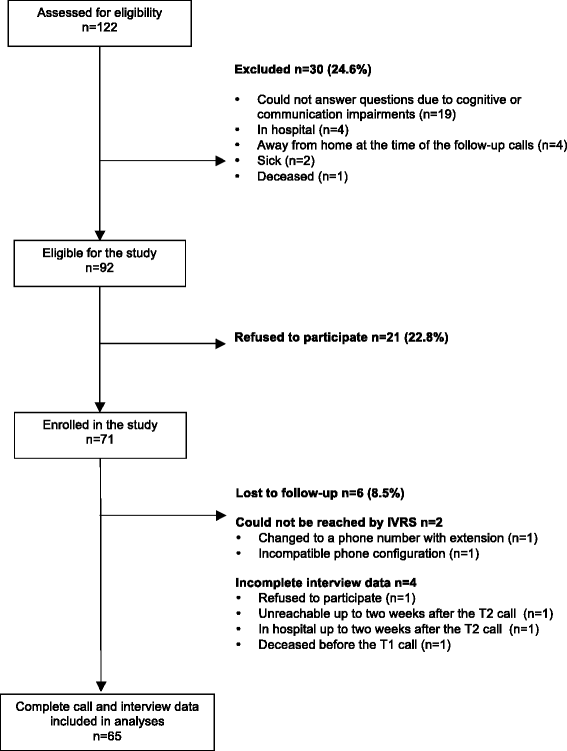Development and feasibility of an automated call monitoring intervention for older wheelchair users: the MOvIT project
- PMID: 26376853
- PMCID: PMC4572692
- DOI: 10.1186/s12913-015-1048-0
Development and feasibility of an automated call monitoring intervention for older wheelchair users: the MOvIT project
Abstract
Background: Recent advances in wheeled mobility technology are multiplying opportunities for community integration and improved quality of life. The mobility needs of older wheelchair users are particularly complex due to a constellation of chronic conditions and comorbidities that may compromise optimal use of the device. The purpose of the Mobility Outcomes via Information Technologies (MOvIT) project is to examine the feasibility of automated calls for the systematic monitoring for adverse outcomes associated with wheelchair use.
Methods: A two-phase mixed methods approach was used. Phase I involved user-centered development and face validation of a monitoring questionnaire with end-users (seven wheelchair users and five healthcare providers). Phase II tested the feasibility of monitoring outcomes using automated calls to administer the MOvIT questionnaire 1 and 3 months after wheelchair delivery with a prospective cohort of older adults (50-84 years of age). When problems were identified, the computer monitoring system notified a clinical coordinator who followed up with respondents requiring interventions. Feasibility data were extracted from the web database and from individual interviews covering perceived ease of use, usefulness and intention to use the MOvIT questionnaire in the future.
Results: The MOvIT monitoring questionnaire developed in phase I tracks nine potential wheelchair-related adverse outcomes considered important for end-users: 1) non-use of wheelchair, 2) pain, 3) skin condition, 4) positioning, 5) wheelchair incidents, 6) psychosocial issues, 7) restricted wheelchair participation, 8) limited wheelchair skills and knowledge, and 9) technical problems. In phase II, 92 individuals who received a wheelchair were eligible, 71 out of 92 accepted (77%) and 65 out of 71 (92%) completed the 3-month follow-up. In the sample of 65 participants, a wheelchair-related adverse outcome was confirmed by a rehabilitation professional for 58.5%, and at least one recommendation was given to 66.2% during the 3-month monitoring period. A majority of participants found the intervention useful (82.8%) and said they intended to use the MOvIT monitoring questionnaire in the future (81.5%). Participants made suggestions to make the calls more adaptive to various ability profiles.
Conclusions: Automated calls tailored for individuals with mobility limitations and associated comorbidities are a promising approach to reach clients who need post-rehabilitation support.
Figures
References
-
- World Health Organization . Guidelines on the provision of manual wheelchairs in less resourced settings. Geneva, Switzerland: WHO Press; 2008. - PubMed
-
- Kaye H, Kang T, LaPlante M. Mobility device use in the United States. Disability statistics report, (14) Washington, DC: U.S. Department of Education, National Institute on Disability and Rehabilitation Research; 2000.
-
- Shields M. Use of wheelchairs and other mobility support devices. Health Rep. 2004;15:37–41. - PubMed
Publication types
MeSH terms
Grants and funding
LinkOut - more resources
Full Text Sources
Other Literature Sources
Medical
Miscellaneous



